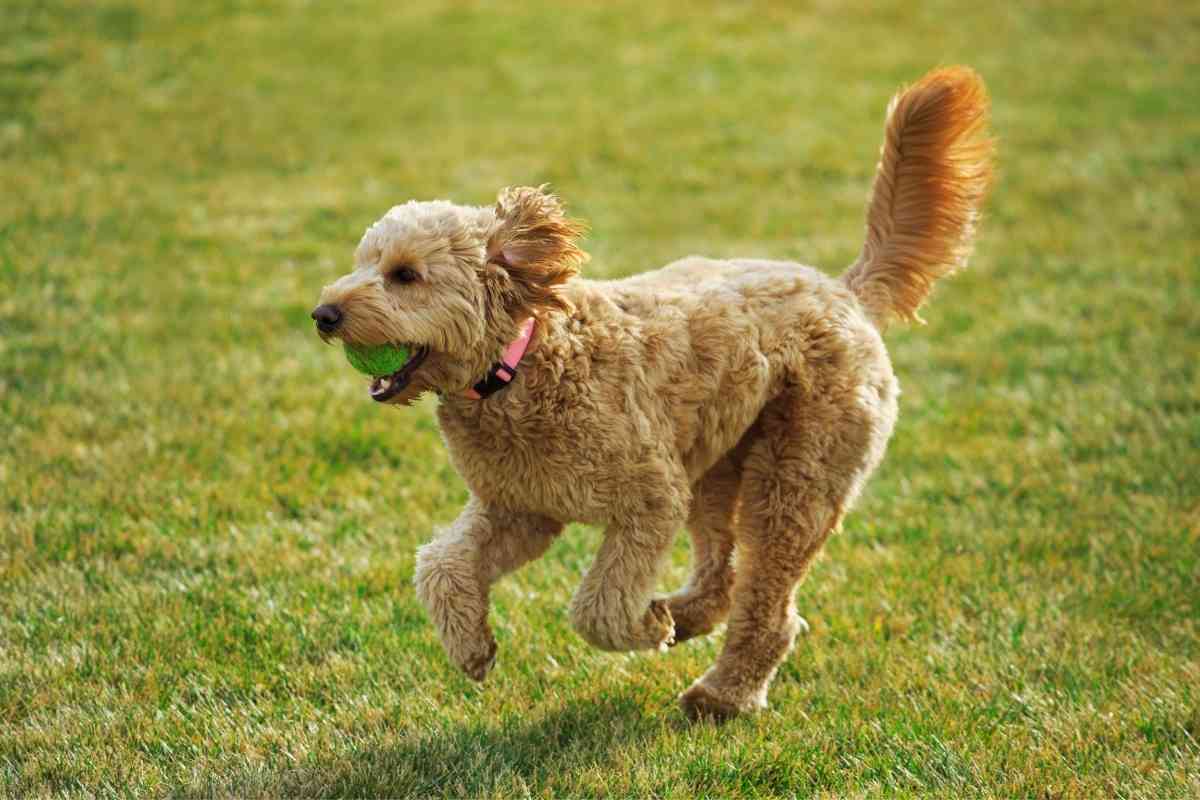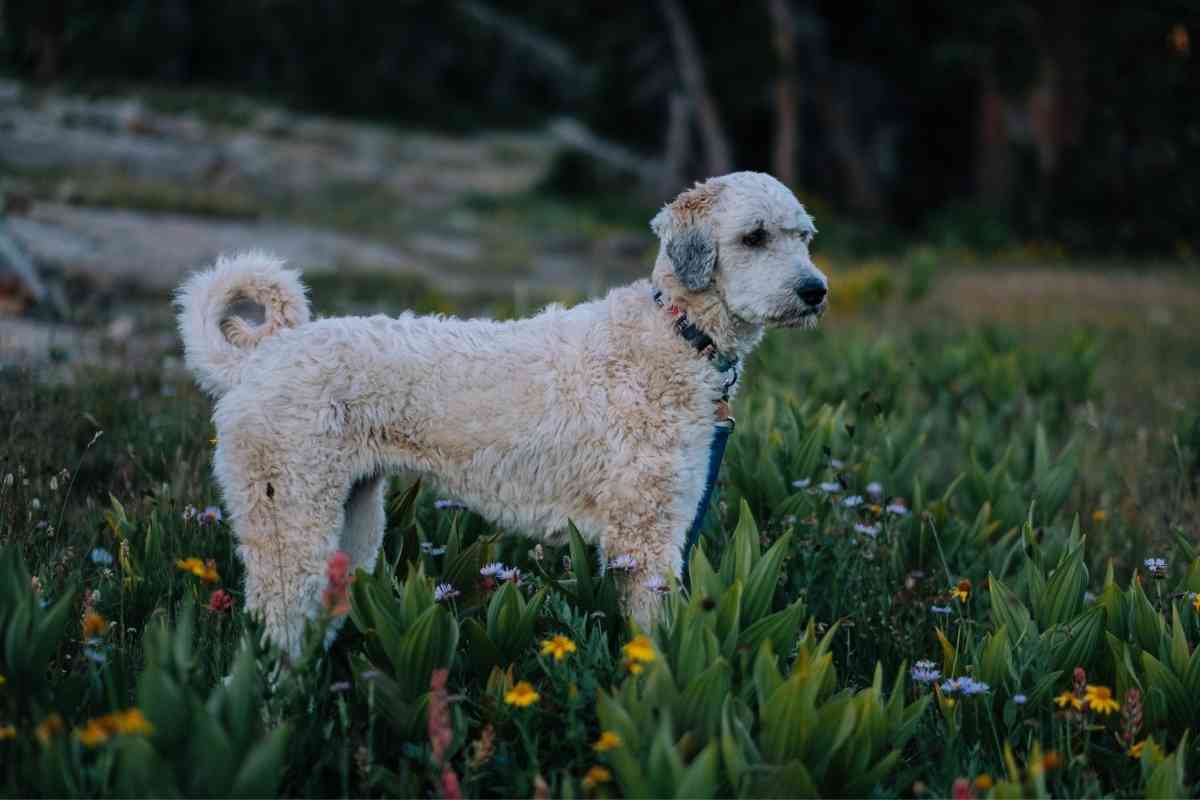Why Does My Goldendoodle Have A Curly Tail?
There is a bit of wonder that draws people to Goldendoodles.
They are a cross between two other well-known breeds, but the excitement of a mixture is: what will the result be?
Many who go out and get a Goldendoodle pup love to think about who their dog will be and maybe which of its parents it will take after more.
Some Goldendoodles even wind up with curly tails, which adds to the intrigue.
Why is that exactly? Where does the curly tail come from? Find out all you need to know and more in the article below!
Why Does My Goldendoodle Have A Curly Tail?
Curly tails in dogs are likely a direct result of domestication – an example of domestication syndrome. Dogs bred over the millennia to be tame underwent physical changes linked to their changing temperament. One of these changes gave us dogs with a curly tail.
Individual Goldendoodles get their curly tail genes from at least one of their parents, most likely on the Poodle side.

What’s in A Tail? Anatomy of a Dog’s Tail
A dog’s tail is an extension of its spine.
Several progressively smaller vertebrae extend out past their rump, narrowing the tail to a tip.
The bones are surrounded by muscles, tendons, and cartilage, which allow dogs a wide range of movement and control.
Dog tails become curled because either the vertebrae are abnormally wedge-shaped (as compared to that of a straight-tailed dog), or because they are fused.
This is a congenital condition called hemivertebrae, and it would cause health problems if it occurred further up the spine.
However, when isolated to the tail, as is the case with curly-tailed breeds, the condition is usually harmless.
The degree and permanence of the curl depends on the exact nature of the vertebrae anomaly.
Tail curliness may also be associated with weaker cartilage in the tail, allowing it to flop around and curl more easily.
What Types of Dogs Have Curly Tails?
Cold-weather-ready dogs like Huskies often have sickle-shaped tails. Shiba Inus and Samoyeds are examples of those with tighter ringed tails. Bulldogs and pugs are examples of breeds that have the tightest curl of all, known as corkscrew tails.
Sickle-Shaped Tail or Ringed Tail
Sickle-shaped tails have a gentle curl to them.
Examples of dogs with tails like these include Akitas, Malamutes, Huskies, and similar breeds.
These dogs retain some ability to either extend the tail straighter, such as when stretching or curl it tighter on their back, as they would when displaying excitement or hostility.
It may not be a coincidence that this type of tail is common to dogs bred to live in cold climates as they use the tail to wrap around their bodies and cover their noses while sleeping, protecting their faces from frostbite.
Ringed tails are a more defined version of sickle-shaped tails.
Also called a curlicue tail, they stay curled tighter over the dog’s back.
Samoyeds, Chow Chows, and Shiba Inus are breeds of dogs with this type of tail.
Corkscrew Tails
Corkscrew tails are characteristic of dogs like pugs and bulldogs. The vertebrae are fused in such a way that the tail stays curled tight like a corkscrew permanently.
These dogs are not able to straighten or change the curl of their tail at all.

Where Do Curly Tails Come From?
Curly tails are an inherited trait, passed down from one generation to the next.
Although technically caused by a genetic defect, curly tails are now of course selected for in certain breeds.
At least one famous study suggests that curly tails may be a direct result of domestication.
Since dogs descended from wolves, the potential for curly tails has always existed in their genetic makeup, even though wolves only have slight curves in their tails at best.
While we do not have details on the exact nature of the transition of wolves to dogs, a study involving foxes has shed light on how the domestication process might have gone and how dogs likely received their curly tails.
The Silver Fox Domestication Experiment
In 1959, Russian geneticists began one of the most famous experiments in biology to date.
The first researcher who began the experiment, Dmitri Belyaev, hypothesized that certain traits shared by domesticated animals (such as floppy ears and curly tails in dogs) were genetically linked to tameness and that by selecting for tameness and only tameness while breeding successively from a population of wild animals, these other physical traits would appear simultaneously as a result.
The prevalence of these traits in domesticated animals is known as domestication syndrome.
To test his hypothesis, Belyaev began breeding wild silver foxes on an experimental farm in Siberia.
They selected the top 10% for tame qualities and allowed them to breed the next generation.
In just six generations, they had produced remarkably tame foxes who wagged their tails and licked human hands.
In less than 10 years, the newly bred foxes began to show signs of domestication syndrome, developing floppy ears, shorter tails, curly tails, mottled coats, and more juvenile face and body features (short, flat snouts and legs).
So, what was causing the changes? Scientists are still unsure of the exact mechanisms, but there are several clues.
Besides changes in appearance and temperament, the tamer silver foxes experienced other significant biological shifts.
Their adrenal glands became smaller, they produced less cortisol (stress hormone), and more serotonin (“happiness” chemical).
Researchers also discovered that, as embryos, the selection for tameness resulted in the migration of fewer neural crest cells.
The embryonic neural crest cells were related to the alterations in the physical traits that they witnessed.
For example, it weakened cartilage, which is directly responsible for both curly tails and floppy ears.
Therefore, this experiment arguably answers the question “why does my Goldendoodle have a curly tail?” in a fundamental way.
Quite simply, your Goldendoodle is a dog, which means it is one of the most domesticated animals on earth, which means that its genetics have been shaped for generations by humans, making it an example of an animal with domestication syndrome.
Your Goldendoodle’s tail is curly for the same reason it licks your hand and loves you – because it is tame.
How cool is that?
Do Poodles or Golden Retrievers Have Curly Tails?
Golden retrievers normally have straight tails or tails with only a slight curve. Poodles normally have their tails docked, and thus they appear straight much of the time. Natural poodle tails may be straight or somewhat curly, but tail curliness in either dog is considered a fault according to their breed standards.
Since Goldendoodles have one parent that is a Golden Retriever and one that is a Poodle, this may cause some extra curiosity regarding their curly tail.
Rarely do either of these parent breeds sport a curly tail, so how could a Goldendoodle have one?
The answer most likely lies in the fact that poodle tails are frequently docked at birth.
The practice is controversial, and while some argue it is healthier and more beautiful for the dog, in general, it is simply tradition and necessary at least for show dogs.
This means that the true nature of the poodle tail is often hidden from us!
Left undocked, poodle tails may appear straight, but some do in fact curl.
If your Goldendoodle has a very curly tail, they likely inherited it primarily from their poodle parent since Golden Retriever tails never exhibit much of a curl.
A Golden Retriever’s tail may be slightly sickle-shaped at best, but curly tails in Goldens are discouraged and they are not bred for it.
This trait may have persisted in some Poodles since the tails are docked anyway and thus there was no reason to breed against it.
What Should A Goldendoodle Tail Look Like? Should it be Docked/Cropped?
Goldendoodles’ tails may be straight or curly.
Unlike Poodles, Goldendoodles are not shown in mainstream dog shows, so there is not the same pressure from a breeding standpoint to dock a Goldendoodle’s tail.
Rather, many owners prefer to have a long or even curly natural tail on a Goldendoodle.
Attitudes on tail docking are constantly evolving as well, and the practice may be more frowned upon than it once was.
Conclusion
Dogs can be our closest companions.
We feel we know everything about them at times, but, then again, they are sometimes still full of mystery! If you were looking at a Goldendoodle the other day and wondering “huh, why does it have a curly tail?”, hopefully now you feel a bit more informed about it!
Now you know that curly tails in dogs likely originated merely as an unintended consequence of the domestication process, and it can be considered a symptom of domestication syndrome.
You know that the physical structure of curled tails differs because of unusual vertebrae and looser cartilage.
Finally, you know that poodles naturally have the curliest tails between the two parent breeds, so your curly-tailed Goldendoodle likely takes after them the most!